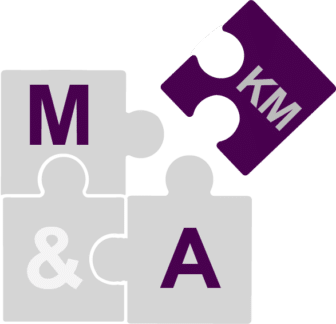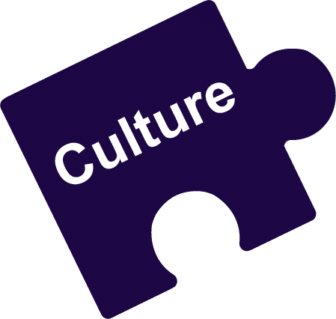Many factors can impact the success of a merger and acquisition (M&A) transaction including economic uncertainty, proper target identification, accurately valuating a target, a stable regulatory and legislative environment, and a sound due diligence process. Due to the COVID-19 pandemic, there is an additional factor: delayed timing in completing M&A deals. It is expected that during 2020, deal timelines for negotiations will be significantly extended.
 If you want to be successful with a merger and acquisition (M&A) transaction, consider developing a Knowledge Management (KM) Strategy to guide the process. One of the most important factors in achieving a successful M&A transaction is “effective integration.” But what does effective integration mean? At EK, we encourage organizations to consider analyzing integration from the five KM perspectives of People, Process, Content, Culture, and Technology. This analysis includes defining both a current state and target state for all five areas. Let’s take a look at how KM best practices for each of those five KM areas can help you achieve an effective integration during a M&A transaction.
If you want to be successful with a merger and acquisition (M&A) transaction, consider developing a Knowledge Management (KM) Strategy to guide the process. One of the most important factors in achieving a successful M&A transaction is “effective integration.” But what does effective integration mean? At EK, we encourage organizations to consider analyzing integration from the five KM perspectives of People, Process, Content, Culture, and Technology. This analysis includes defining both a current state and target state for all five areas. Let’s take a look at how KM best practices for each of those five KM areas can help you achieve an effective integration during a M&A transaction.
People

The people aspect of KM refers to how the overarching structure of leadership and staff supports knowledge flow throughout the organization, and how people communicate and connect with one another to more effectively create and share knowledge. Traditionally, a large portion of M&A transactions have focused on acquiring thoughts, methodologies, people, and relationships. When two separate entities combine forces to create a new organization, or when a company takes over another, people and relationships from both sides are inevitably impacted. Due to the COVID-19 pandemic, it is now even more important to determine whether both entities have enough employees and resources to successfully continue business operations. A KM Strategy can help identify and prioritize the skill sets required at all levels in the organization to grow the new, joint business.
Most importantly, it is essential to analyze the softer and more human side of employees during a transaction. Employees from the two entities may experience different levels of anxiety that emanate from uncertainty around job security and future responsibilities. Addressing their concerns, and considering how to utilize their skills under the new structure will not only help establish high-performing teams, but most importantly, will boost morale and help keep employees happy. Increasing employee satisfaction in turn improves retention rates and reduces turnover, ensuring the organization holds on to motivated individuals who are then willing to create and share innovative content that would have otherwise been lost if they had been left the organization. Additionally, strengthening leadership and workforce around KM practices, such as establishing rewards and recognition mechanisms for sharing knowledge and embedding content management tasks in daily job processes can help create value from the knowledge held by both organizations, while encouraging knowledge creation, retention, and collaboration.
The creation of Communities of Practice and other similar knowledge sharing mechanisms can help improve the performance of members from both organizations by enabling individuals who share common objectives and work practices to discuss and find ways to improve them. Additionally, these knowledge sharing mechanisms can help encourage innovation in the new merged organization and enable individuals to learn from others that they might not interact with on a daily basis. Even though calculating the return on investment (ROI) of knowledge sharing mechanisms can be seen as challenging, consider estimating the cost savings due to knowledge sharing activities. For example, you can estimate the number of hours that members of a Community of Practice can save when they are able to find templates or subject matter experts on the community page to accomplish specific business objectives that otherwise would have taken them a long time. Another example of ROI for knowledge sharing activities is estimating call deflection for internal support teams. By having support documentation available in a knowledge sharing repository (e.g. an internal IT Support page), the new joint organization can save time and money as a result of the reduction of phone calls, emails, and chat sessions from employees to the IT team.
Process

Before deciding to move forward with a M&A transaction, you need to understand each side’s business operations, along with associated business processes, key players, and any major pain points. Typically, mid-level managers from various business areas are tasked with integrating their own operations with the other company’s operations without fully understanding what it takes to be successful. A KM Strategy can certainly help with the effort of identifying and improving core business processes for the merged organization. From a KM perspective, a primary goal of optimizing business processes should be to systematically capture, manage, and enhance information, while making optimal use of resources, minimizing costs, and maintaining high-quality operations. Hand-in-hand with process optimization should be the decision on which business processes to automate. Business process automation involves identifying which specific steps or recurring tasks could be executed with a technology and then choosing the right tool to achieve it. Optimizing business processes and automating them wherever possible will allow organizations to experience better flow of information, increased efficiency, streamlined tasks, better utilization of resources, and end-to-end visibility of the new, joint operations.
From a content management perspective, understanding how key organizational content gets created, tagged, and shared is also critical. Identifying not only what the major areas of content are, but also who the content creators and content owners are, where content is stored, which taxonomies are leveraged for tagging, and most importantly how content flows through the organization will get you in the right direction to manage content effectively. Successful integration of the two organizations in a M&A transaction involves translating very distinct content management processes from each party into new, joint content management processes that align with the business goals of the M&A transaction. As part of a KM Strategy, a robust content and taxonomy governance plan will help you define the roles, responsibilities, policies, and processes necessary to support the flow of content in the new organization.
Content

As you explore the possibility of a M&A, it is essential to determine the knowledge, information, and data management needs of the target state for the merged organization. Performing a content inventory and developing a content clean-up strategy for both entitiesare recommended first steps. A content inventory will allow the merged organization to assess the state of content from various content sources (e.g., document management systems, content management systems, shared drives, etc.), achieve a full understanding of each system’s content (types of content, volume, state, and location), and define a content strategy. The content strategy should address the optimization of content types as well as the definition of user-centric business taxonomies that would help achieve the ideal state for content creation, management, and search. A complete content inventory and a thorough clean-up effort are part of the foundational activities needed to achieve an optimal enterprise search experience, especially after a M&A transaction where outdated or inaccurate content could pose a risk to the operations of the merged organization.With so much information available from both organizations it will be difficult to determine what is current or what is relevant unless a content clean-up effort has been completed.
Following the completion of the content inventory, both organizations need to assess the quality of their content to inform future clean-up or migration efforts (whether to maintain, delete, or archive certain content), and determine a governance plan to ensure the effectiveness and sustainability of any new content management activities. As a next step, it’s important to determine whether the existing technologies meet the business’ knowledge, information, and data management needs or whether new technologies will be needed after the M&A is complete. The goal of conducting a content inventory and developing a content clean-up strategy is to ensure that people have access to the most relevant and up-to-date content (NERDy content), while experiencing improved content findability and reduced content clutter that may result from the M&A effort.
Culture

From a KM perspective, culture refers to employees’ willingness to share, collaborate, and support one another, and whether innovation and change are encouraged and valued across the organization. During a M&A, you are merging more than two companies’ assets, products, and services. Most importantly, you are merging people, personalities, and organizational cultures. Additionally, if you consider a global merger, you are integrating with other nation’s cultures and languages which adds even more complexity. Organizational culture can positively or negatively influence many aspects of a company including sales, profits, employee engagement, collaboration, and even recruiting activities. A unique and fun corporate culture can be considered among the most important assets for certain organizations. However, a M&A could change that overnight.
Although a company’s culture is especially shaped by its founder and executives, it is highly influenced by employees’ experiences and daily work practices. From a KM perspective, people management practices from both organizations need to be analyzed and validated to determine compatibility, ideally before moving forward with the merger. The lack of compatibility in corporate cultures and people management practices increases the likelihood of a failed M&A transaction and poses a serious risk to the expected synergy among employees from both organizations to effectively work together to create, and share knowledge under the newly merged organization. Furthermore, this could impact the definition of measurable success criteria that make sense to everyone in the new organization to track productivity and progress with KM initiatives. The changes introduced by the COVID-19 pandemic have also posed new questions for organizations as leaders reflect on how to sustain culture and best manage their people while they are working remotely. A KM Strategy can help overcome many of these challenges by helping evaluate, among other things, whether the organizations involved in the transaction encourage innovation, knowledge sharing, collaboration, and openness to change, and whether measurable success criteria exist to demonstrate the value of KM initiatives. Conducting a cultural assessment of both organizations before moving forward with the M&A is a key component of the KM Strategy to determine whether the merger of people, personalities, and organizational cultures would work.
Technology
One of the biggest challenges during a M&A is dealing with the different systems and technologies from both organizations and not having a clear plan on which ones to use or how to consolidate them. Often, after a M&A, the merged organization ends up with a lot of different technologies, including “shadow IT” (technologies and applications introduced to the organization without explicit approval  from an IT department) that makes it difficult for employees to work efficiently, and for the IT department to support them effectively. The use of “shadow IT” has increased exponentially in recent years, especially due to the availability of free or low cost cloud-based applications and services. After a M&A transaction is completed, the sudden appearance of siloed applications, or duplicated, overlapping technologies as a result of shadow IT from each organization makes managing content effectively and achieving enterprise search a challenge. Furthermore, by definition, technologies that are considered shadow IT are not standardized or accessible across the organization, compromising access to content and potentially impacting the completion of daily job functions successfully. The COVID-19 pandemic has also introduced a new technology challenge due to the manner in which M&A are now being developed and negotiated. Nowadays, executives and other key personnel – buyers, sellers, providers of M&A financing, and legal advisors – involved in M&A transactions are working remotely, increasing the need to identify real-time collaboration technologies that allow them to interact with each other in a time-efficient manner.
from an IT department) that makes it difficult for employees to work efficiently, and for the IT department to support them effectively. The use of “shadow IT” has increased exponentially in recent years, especially due to the availability of free or low cost cloud-based applications and services. After a M&A transaction is completed, the sudden appearance of siloed applications, or duplicated, overlapping technologies as a result of shadow IT from each organization makes managing content effectively and achieving enterprise search a challenge. Furthermore, by definition, technologies that are considered shadow IT are not standardized or accessible across the organization, compromising access to content and potentially impacting the completion of daily job functions successfully. The COVID-19 pandemic has also introduced a new technology challenge due to the manner in which M&A are now being developed and negotiated. Nowadays, executives and other key personnel – buyers, sellers, providers of M&A financing, and legal advisors – involved in M&A transactions are working remotely, increasing the need to identify real-time collaboration technologies that allow them to interact with each other in a time-efficient manner.
Creating an inventory of technologies, systems and applications used by the two companies as part of a KM Strategy will get you started on the right path. Before making decisions about which systems to maintain and which ones to consolidate, you need to know what you have in-house. Next steps include determining the technology needs for the merged organization and conducting technology assessments. These assessments will help you make better, people-focused decisions when it comes to KM technology as you determine the need for office productivity systems, document management systems, content management systems, process automation applications, collaboration tools, taxonomy and ontology tools, search engines, and Artificial Intelligence (AI) solutions, among others. Finally, training end users and determining the level of support that your IT department can provide will help achieve the desired level of systems adoption.
At EK, we believe that even though choosing the right technology is an important KM element in a M&A transaction, the other four elements (People, Process, Content, and Culture) should be the driving forces of the transaction. If those four elements are aligned correctly, choosing the technology that will support them should be the final step that optimizes operations and how people work together.
Conclusion
Despite the effort that organizations go through to achieve their goal of performance improvement through a M&A, the results are often disappointing and differ from the results originally predicted. Knowing that one of the biggest problems that companies encounter during a M&A transaction is the lack of planning around integration at various organizational levels, incorporating a KM Strategy early in the process is a smart way towards a smooth and successful M&A transaction.
If you need help designing a KM Strategy for your M&A, contact us.
